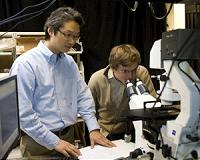 |
New York NY (SPX) Jan 06, 2011 As every middle-school child knows, in the process of photosynthesis, plants take the sun's energy and convert it to electrical energy. Now a Tel Aviv University team has demonstrated how a member of the animal kingdom, the Oriental hornet, takes the sun's energy and converts it into electric power - in the brown and yellow parts of its body - as well. "The interesting thing here is that a living biological creature does a thing like that," says physicist Prof. David Bergman of Tel Aviv University's School of Physics and Astronomy, who was part of the team that made discovery. "The hornet may have discovered things we do not yet know." In partnership with the late Prof. Jacob Ishay of the university's Sackler Faculty of Medicine, Prof. Bergman and his doctoral candidate Marian Plotkin engaged in a truly interdisciplinary research project to explain the biological processes that turn a hornet's abdomen into solar cells. The research team made the discovery several years ago, and recently tried to mimic it. The results show that the hornet's body shell, or exoskeleton, is able to harvest solar energy. They were recently published in the German journal Naturwissenschaften.
Discovering a new system for renewable energy? Taking this information to the lab, the Tel Aviv University team studied weather conditions like temperature, humidity and solar radiation to determine if and how these factors also affected the hornet's behavior, but found that UVB radiation alone dictated the change. In the course of their research, the Tel Aviv University team also found that the yellow and brown stripes on the hornet abdomen enable a photo-voltaic effect: the brown and yellow stripes on the hornet abdomen can absorb solar radiation, and the yellow pigment transforms that into electric power. The team determined that the brown shell of the hornet was made from grooves that split light into diverging beams. The yellow stripe on the abdomen is made from pinhole depressions, and contains a pigment called xanthopterin. Together, the light diverging grooves, pinhole depressions and xanthopterin change light into electrical energy. The shell traps the light and the pigment does the conversion.
A biological heat pump To see if the solar collecting prowess of the hornet could be duplicated, the team imitated the structure of the hornet's body but had poor results in achieving the same high efficiency rates of energy collection. In the future, they plan to refine the model to see if this "bio-mimicry" can give clues to novel renewable energy solutions. The research team also discovered that hornets use finely honed acoustic signals to guide them so they can build their combs with extraordinary precision in total darkness. Bees can at least see what they are doing, explains Prof. Bergman, but hornets cannot - it's totally dark inside a hornet nest.
Share This Article With Planet Earth
Related Links Tel Aviv University All About Solar Energy at SolarDaily.com
 New Solar Cell Self-Repairs Like Natural Plant Systems
New Solar Cell Self-Repairs Like Natural Plant SystemsWest Lafayette IN (SPX) Jan 05, 2011 Researchers are creating a new type of solar cell designed to self-repair like natural photosynthetic systems in plants by using carbon nanotubes and DNA, an approach aimed at increasing service life and reducing cost. "We've created artificial photosystems using optical nanomaterials to harvest solar energy that is converted to electrical power," said Jong Hyun Choi, an assistant professo ... read more |
|
| The content herein, unless otherwise known to be public domain, are Copyright 1995-2010 - SpaceDaily. AFP and UPI Wire Stories are copyright Agence France-Presse and United Press International. ESA Portal Reports are copyright European Space Agency. All NASA sourced material is public domain. Additional copyrights may apply in whole or part to other bona fide parties. Advertising does not imply endorsement,agreement or approval of any opinions, statements or information provided by SpaceDaily on any Web page published or hosted by SpaceDaily. Privacy Statement |